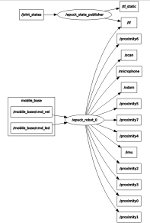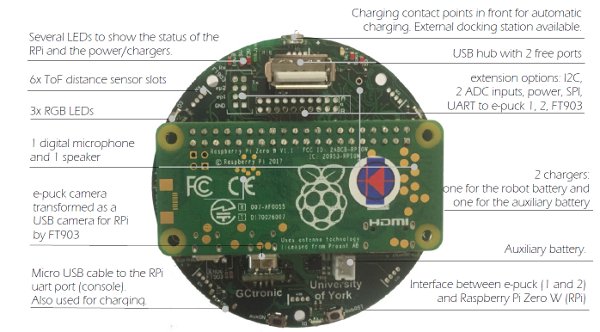Pi-puck
Overview
- Raspberry Pi zero W (rPi) connected to the robot via I2C
- interface between the robot base camera and the rPi via USB
- 1 digital microphone and 1 speaker
- USB hub connected to the rPi with 2 free ports
- uUSB cable to the rPi uart port. Also ok for charging
- 2 chargers. 1 for the robot battery and 1 for the auxiliary battery on top of the extension
- charging contact points in front for automatic charging. External docking station available
- several extension options. 6 i2C channels, 2 ADC inputs
- several LED to show the status of the rPi and the power/chargers
Getting started
This introductory section explains the minimal procedures needed to work with the Raspberry Pi Zero W mounted on the Pi-puck extension board and gives a general overview of the available basic demos and scripts shipped with the system flashed on the micro SD. More advanced demos are described in the following separate sections (e.g. ROS), but the steps documented here are fundamental, so be sure to fully understand them.
The extension is mostly an interface between the e-puck robot and the Raspberry Pi, so you can exploit the computational power of a Linux machine to extend the robot capabilities.
In most cases, the Pi-puck extension will be attached to the robot, but it's interesting to note that it can be used also alone when the interaction with the robot isn't required.
The following sections assume the full configuration (robot + extension), unless otherwise stated.
Requirements
The robot must be programmed with a special firmware in order to communicate via I2C bus with the Raspberry Pi mounted on the Pi-puck extension.
e-puck1
e-puck2
The e-puck2 robot must be programmed with the following firmware e-puck2_main-processor_gumstix.elf and the selector must be placed in position 10.
Turn on/off the extension
Console mode
The Pi-puck extension board comes with a pre-configured system ready to run without any additional configuration.
In order to access the system from a PC in console mode, the following steps must be performed:
1. connect a micro USB cable from the PC to the extension module. If needed, the drivers are available in the following link USB to UART bridge drivers
2. execute a terminal program and configure the connection with 115200-8N1 (no flow control). The serial device is the one created when the extension is connected to the computer
3. switch on the robot (the extension will turn on automatically); now the terminal should display the Raspberry Pi booting information. If the robot isn't present, then you can directly power on the extension board with the related button
4. login with user = pi, password = raspberry
Startup configuration
The following commands need to be executed at each startup, alternatively you can set to run them automatically at startup:
/home/pi/i2c_enable
- this is neeeded to enable the I2C bus
sudo python3 /home/pi/camera-test.py
- this is needed to correctly configure the camera of the robot
Communicate with the robot
Communicate with the IMU
Communicate with the ToF sensor
Capture an image
Remember to follow the steps in the section System: Startup configuration if not already done.
The robot camera is connected to the Pi-puck extension as a USB camera, so you can access it very easily.
A small grabbing demo is available on the system
Audio recording
Audio play
WiFi configuration
File transfer
Operating system
The system is based on Raspbian Stretch and can be downloaded from the following link gctronic-stretch-ros-kinetic-opencv3.4.1.img.tar.gz.
When booting the first time, the first thing to do is expanding the file system in order to use all the available space on the micro sd:
1. sudo raspi-config
2. Select Advanced Options and then Expand Filesystem
3. reboot
Desktop mode
The system starts in console mode, to switch to desktop (LXDE) mode issue the command startx.
Camera viewer
ROS
ROS Kinetic is integrated in the Pi-puck system.
Initial configuration
The ROS workspace is located in ~/rosbots_catkin_ws/
The e-puck2 ROS driver is located in ~/rosbots_catkin_ws/src/epuck_driver_cpp/
Remember to follow the steps in the section Requirements , only once.
Remember to follow the steps in the section System: Startup configuration, each time the system is powered on.
The PC (if used) and the Pi-puck extension are supposed to be configured in the same network.
Running roscore
roscore can be launched either from the PC or directly from the Pi-puck.
Before starting roscore, open a terminal and issue the following commands:
export ROS_IP=roscore-ipexport ROS_MASTER_URI=http://roscore-ip:11311
where roscore-ip is the IP of the machine that runs roscore
Then start roscore by issueing roscore.
Running the ROS node
Before starting the e-puck2 ROS node on the Pi-puck, issue the following commands:
export ROS_IP=pipuck-ipexport ROS_MASTER_URI=http://roscore-ip:11311
where pipuck-ip is the IP of the Pi-puck extension and roscore-ip is the IP of the machine that runs roscore (can be the same IP if roscore runs directly on the Pi-puck).
To start the e-puck2 ROS node issue the command:
roslaunch epuck_driver_cpp epuck_minimal.launch debug_en:=true ros_rate:=20
The following graph shows all the topics published by the e-puck2 driver node:
 Click to enlarge
Click to enlarge
Get the source code
The last version of the e-puck2 ROS node can be downloaded from the git: git clone -b e-puck2 https://github.com/gctronic/epuck_driver_cpp.git
OpenCV
OpenCV 3.4.1 is integrated in the Pi-puck system.
